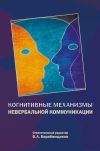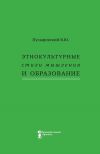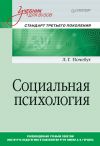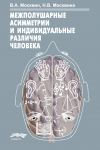Текст книги "Человек и этнос. Восприятие, оценка, самооценка"

Автор книги: Коллектив авторов
Жанр: Социальная психология, Книги по психологии
сообщить о неприемлемом содержимом
Текущая страница: 17 (всего у книги 18 страниц)
64. Карандашев В. Н. Методика Шварца для изучения ценностей личности: концепция и методическое руководство. СПб.: Речь, 2004.
65. Коул М. Культурно-историческая психология: наука будущего. М.: Когито-центр, 1997.
66. Крысько В. Г. Этническая психология. 4-е изд. М.: Академия, 2008.
67. Кульбиков В. П. Звуковая интеграция как процесс эволюционного развития функциональной системы психической деятельности человека: Монография. Хабаровск: ОПП Крайкомстата, 1999.
68. Ламажаа Ч. К. Национальный характер тувинцев. М.-СПб.: Нестор-История, 2018.
69. Ланге Г. Душевные движения // Психология эмоций: Хрестоматия / Авт. – сост. В. К. Вилюнас. СПб.: Питер, 2004. С. 112–130.
70. Леонова А. Б., Кузнецова А. С. Психологические технологии управления состоянием человека. М.: Смысл, 2007.
71. Леонтьев А. Н. Лекции по общей психологии. М.: Смысл, 2000.
72. Леонтьев А. Н. Потребности, мотивы и эмоции. М.: Изд-во Моск. ун-та, 1971.
73. Леонтьев А. Н. Эволюция психики. М.: МПСИ; Воронеж: НПО «Модэк», 1999.
74. Леонтьев Д. А. Тест смысложизненных ориентаций (СЖО). 2-е изд. М.: Смысл, 2000.
75. Леонтьев Д. А. Три грани смысла // Традиции и перспективы деятельностного подхода в психологии: школа А. Н. Леонтьева / Под ред. А. Е. Войскунского, А. Н. Ждан, О. К. Тихомирова. М.: Смысл, 1999. С. 299331.
76. Линдсли Д.Б. Эмоции // Экспериментальная психология / Под ред. С. С. Стивенса. М.: Изд-во иностр. литры, 1960. С. 629–684.
77. ЛукА.Н. Эмоции и личность. М.: Знание, 1982.
78. Лурия А. Р. Об историческом развитии познавательных процессов. М.: Наука, 1974.
79. Лурия А. Р. Язык и сознание. М.: Изд-во Моск. ун-та, 1998.
80. Мацумото Д. Психология и культура. СПб.: Питер, 2003.
81. Межличностное восприятие в группе / Под ред.
Г. М. Андреевой, А. И. Донцова. М.: Изд-во Моск. унта, 1981.
82. Мещеряков Б. Г., Пономарев И. В. Майкл Коул как медиатор и интегратор культурно-исторической психологии // Культурно-историческая психология. 2018. Т. 14. № 4. С. 52–63. doi: 10.17759/chp.2018140407.
83. Мещеряков Б. М, Зинченко В. П. Большой психологический словарь / Сост. и общ. ред. Б. Мещеряков, В. Зинченко. СПб.: Прайм-Еврознак, 2003.
84. Морозов В. П. О психофизических коррелятах эстетических свойств голоса певцов разных профессиональных уровней // Психофизика сегодня / Под ред. В. Н. Носуленко, И. Г. Скотниковой. М.: Изд-во «Институт психологии РАН», 2007. С. 65–75.
85. Мышлявцев Б. А. Современная Тува: нормативная культура (конец XX-начало XXI в.). Дис… канд. истор. наук. Новосибирск, 2002.
86. Мясищев В. Н. Личность и нервозы. Л.: Изд-во Ленинград. ун-та, 1960.
87. Непомнящая Н. И, Каневская М. Е, Пахомова О. Н, Барцалакина В. В, Рубцова С. Н, Музе Э. Н. Ценностность как центральный компонент психологической структуры личности // Вопросы психологии. 1980. № 1. С. 103
111.
88. Носуленко В. Н. Психофизика восприятия естественной среды: проблема воспринимаемого качества. М.: Изд-во «Институт психологии РАН», 2007.
89. Носуленко В. Н, Самойленко Е. С. Вербальный метод в изучении восприятия изменений в окружающей среде // Психология и окружающая среда. М.: Изд-во «Институт психологии РАН», 1995. С. 11–50.
90. Носуленко В. Н, Самойленко Е. С, Выскочил Н. А. Парадигма воспринимаемого качества в изучении изменений акустической среды // Психологические и психоаналитические исследования: Ежегодник 2015–2016 / Под ред. А. А. Демидова. М.: Московский институт психоанализа, 2016. C. 8—30.
91. Носуленко В. Н, Харитонов А. Н. Жизнь среди звуков: психологические реконструкции. М.: Изд-во «Институт психологии РАН», 2018.
92. Панкратова А. А, Осин Е. Н, Люсин Д. В. Особенности эмоционального интеллекта у представителей российской и азербайджанской культур // Психологические исследования. 2013. Т. 6. № 31. С. 11. URL: http:// psystudy.ru (дата обращения: 30.06.2019).
93. Разумкова А. В. Коми, какие они? Или автостереотипы и гетеростереотипы коми (зыря) // Вопросы психолингвистики. 2017. Т. 31. № 1. С. 188–202.
94. Реан А. А., Бордовская Н. В., Розум С. И. Психология и педагогика. СПб.: Питер, 2010.
95. Рейтинг российских регионов по качеству жизни – 2017. МИА Россия сегодня. 2017. URL: https://ria.ru/ infografika/20180214/1514552265.html (дата обращения: 08.11.2019).
96. Рогинский Я. Я., Левин М. Г. Антропология: Учебное пособие. 3-е изд. М.: Высшая школа, 1978.
97. Рубинштейн С. Л. Основы общей психологии. СПб: Питер, 2001.
98. Симонов П. В. Эмоциональный мозг. М.: Наука, 1981.
99. Симонова О.А. Базовые принципы социологии эмоций // Вестник СПбГУ Сер. 12. «Социология». 2016. Вып. 4. С. 12–27. doi: 10.21638/11701/spbu12.2016.401.
100. Смирнова Е. О. К проблеме воли и произвольности в культурно-исторической психологии // Культурноисторическая психология. 2015. Т. 11. № 3. С. 9–15. doi: 10.17759/chp.2015110302.
101. Смирнова Е. О. Развитие воли и произвольности в онтогенезе // Вопросы психологии. 1990. № 3. С. 49–57.
102. Соколова Д. А. Социально-психологические характеристики общности этнических корейцев Приморского края // Социальные исследования. 2016. № 3. С. 24–37.
103. Солдатова Г. У. Психология межэтнической напряженности. М.: Смысл, 1998.
104. Стефаненко Т. Г. Социальные стереотипы и межэтнические отношения // Общение и оптимизация совместной деятельности / Под ред. Г. М. Андреевой, Я. Яноушека. М.: Изд-во Моск. ун-та, 1987. С. 242250.
105. Теплов Б. М. Психология музыкальных способностей // Избранные труды. М.: Педагогика, 1985. С. 42–222.
106. Товуу Н. О. Психология семьи тыва этноса в условиях социально-экономических изменений: Дис… докт. психол. наук. М., 2001.
107. ФестингерЛ. Теория когнитивного диссонанса. СПб.: Речь, 2000.
108. Франкл В. Воля к смыслу: Основы и применение логотерапии // Воля к смыслу. М.: Апрель-Пресс-Эксмо, 2000. С. 213–366.
109. Фромм Э. Ради любви к жизни. М.: АСТ, 2000.
110. Хекхаузен Х. Мотивация и деятельность. М.: Смысл, 2003.
111. Шабаев Ю. Этническое самосознание народов коми: основа интеграции или база дезинтеграции? // Рубеж: альманах социальных исследований. 1998. № 12. С. 193–208.
112. Шабаев Ю. П, Жеребцов И. Л., Журавлев П. С. «Русский север»: культурные границы и культурные смыслы // Мир России: Социология, этнология. 2012. Т. 21. № 4. С. 134–153.
113. Шапкин С.А. Экспериментальное изучение волевых процессов. М.: Смысл, 1997.
114. Шаховский В. И. Эмоции: Долингвистика, лингвистика, линвокультурология. М.: КД «Либроком», 2016.
115. Шляпников В. Н. Взаимосвязь показателей состояния волевой регуляции и этнической идентичности // Культурно-историческая психология. 2019. Т. 15. № 3. С. 83–90. doi: 10.17759/chp.2019150309.
116. Шляпников В. Н. Гендерные особенности волевой регуляции // Вестник МГОУ Сер. «Психологические науки». 2011. № 1. С. 26–38.
117. Шляпников В. Н. Исследования волевой регуляции в современной зарубежной психологии // Вопросы психологии. 2009. № 2. С. 54–63.
118. Шляпников В. Н. Особенности волевой регуляции у кабардинцев, коми, тувинцев и русских // Экспериментальная психология. 2018. Т. 11. № 4. С. 107–115. doi: 10.17759/exppsy.2018110409.
119. Шляпников В. Н. Особенности волевой регуляции у тувинцев и русских // Психология состояний человека: актуальные теоретические и прикладные проблемы: Материалы 3-ей Международной научной конференции. Казань, 8-10 ноября 2018 г. / Отв. ред. Б. С. Алишев, А. О. Прохоров, А. В. Чернов. Казань: Изд-во Казан. ун-та, 2018. С. 586–589.
120. Шляпников В. Н, Ри С. А. Особенности волевой регуляции у корейцев и русских // Психология психических состояний: Сборник статей студентов, магистрантов, аспирантов и молодых ученых / Под ред. А. В. Чернова, М. Г. Юсупова. Казань: Изд-во Казан. ун-та, 2019. Вып. 13. С. 279–282.
121. Шляпников В. Н. Связь традиционного образа жизни и особенностей состояния волевой регуляции // Актуальные проблемы психологии и педагогики в современном мире: Сборник научных трудов участников IV Межвузовской научно-практической конференции. Москва, РУДН, 4 апреля 2019 г. / Под общ. ред. Н. Б. Карабущенко, Н. Л. Сунгуровой. М.: РУДН, 2019. С. 151–156.
122. Шляпников В. Н. Уроки зарубежной психологии воли // Актуальные проблемы психологического знания. 2019. № 3–4. C. 83–92.
123. Шляпников В. Н. Этнокультурные особенности реализации намерения в действии // Ананьевские чтения -2018: Психология личности: традиции и современность: Материалы международной научной конференции, 23–26 октября 2018 г. / Под общ. ред. Н. В. Гришиной, С. Н. Костроминой; отв. ред. И. Р Муртазина, М. О. Аванесян. СПб., 2018. С. 346.
124. Шляпников В. Н, Авдеева О. В. Особенности проявлений волевой регуляции у коми-зырян и русских // Экспериментальная психология. 2018. Т. 11. № 2. С. 121–129.
125. Эверли Дж. С, Розенфельд Р. Стресс. Природа и лечение. М.: Медицина, 1985.
126. Экман П. Психология эмоций. Я знаю, что ты чувствуешь. СПб.: Питер, 2010.
127. Этнолукизм: эмпирическая модель и методы исследования: Коллективная монография / Под ред. В. А. Лабунской. Ростов-на-Дону: Мини Тайп, 2018.
128. Aiello L. M, Schifanella R, Quercia D, Aletta F. Chatty maps: constructing sound maps of urban areas from social media data // Royal Society open science. 2016. V. 3. № 3. Article 150690.
129. Argyle M, Cook M. Gaze and mutual gaze. Cambridge: Cambridge University Press, 1976.
130. Arnold M.B. Emotion and Personality. N.Y.: Columbia University Press, 1960.
131. Asutay E, Vastfjall D. Attentional and emotional prioritization of the sounds occurring outside the visual field // Emotion. 2015a. V. 15 (3). P 281–286.
132. Asutay E., Vastfjall D. Negative emotion provides cues for orienting auditory spatial ttention // Frontiers in Psychology. 2015b. V. 6. Article 618.
133. Asutay E, VastfjallD, Tajadura-JimenezA, GenellA, Bergman P, Kleiner M. Emoacoustics: A Study of the Psycho-acoustical and Psychological Dimensions of Emotional Sound Design // Journal of the audio engineering society.
2012. V. 60. № 1–2. P 21–28.
134. Bachorowski J. A. Vocal expression and perception of emotion // Current directions in psychological science. 1999. № 6. P 53–57.
135. Bachorowski J. A., Owren M. J. Not all laughs are alike: Voiced but not unvoiced laughter readily elicits positive affect // Psychological science. 2001. V. 12. № 3. P 252–257.
136. BagozziR. P, Belschak F, Verbeke W, Gavino J. C. Jr. Salesperson self-regulation of pride: Effects on adaptability, effort and citizenship behaviors between independent-based and interdependent-based cultures // Revista Espanola de Investigation en Marketing ESIC. 2016. P 1-17.
137. BagozziR. P, BaumgartnerH, PietersR. Goal-directed emotions // Cognition and Emotion. 1998. V. 12 (1). P 1—26.
138. Baumann N, Kazan M, Quirin M., Koole S. L. Why People Do the Things They Do: Building on Julius Kuhl’s Contributions to the Psychology of Motivation and Volition. Ho-grefe Publishing, 2018.
139. BaumeisterR. F, Vohs K. D. Strength Model of Self-Regulation as Limited Resource: Assessment, Controversies, Update // Advances in Experimental Social Psychology. 2016. V. 54. P 67-127.
140. Benzecri J.-P. Analyse des Donnes // L’analyse de Correspondences. Paris: Dunod, 1973. V. 2.
141. Bergman P, Vastfjall D, Tajadura-Jime'nez A., Asutay E. Auditory-induced emotion mediates perceptual categorization of everyday sounds // Frontiers in Psychology. 2016. V. 7. Article 1565.
142. Boiger M, Gungor D, Karasawa M. Defending honor, keeping face: Interpesonal affordances of anger and shame in Turkey and Japan // Cognition & Emotion. 2014. V. 28 (7). P. 1255–1269.
143. Bozzoli F, Armelloni E, Ugolotti E. et al. Effects of the Background Noise on the Perceived Quality of Car Audio Systems // Paper presented at the 112th AES Convention. Munich, Germany. 2002. 10–13 May.
144. Bradley M. M, Lang P. J. Affective reactions to acoustic stimuli // Psychophysiology. 2000. V. 37. P 204–215.
145. Brady N, Campbell M, Flaherty M. Perceptual asymmetries are preserved in memory for highly familiar faces of self and friend // Brian and Cognition. 2005. V. 58. P 334342.
146. Brooks J. A, Chikazoe J, Sadato N, Freeman J. B. The neural representation of facial-emotion categories reflects conceptual structure // Proceedings of the National Academy of Sciences. 2019. V. 116 (32). P. 15861-15870. doi: 10.1073/ pnas.1816408116.
147. Brown A. L. Soundscape planning as a complement to environmental noise management // Inter-noise 2014. Melbourne, Australia. 16–19 November, 2014.
148. Brown S. P, Cron W. L, Slocum J. W. Jr. Effects of goal-directed emotions on salesperson volition, behavior, and performance: A longitudinal study // J. marketing. 1997. V. 61 (1). P. 39–50.
149. Brunet P. M, Heisz J. J., Mondloch C. J., Shore D. I., Schmidt L. A. Shyness and face scanning in children // Journal of Anxiety Disorders. 2009. V. 23. Р 909–914.
150. Bryant G. A., Fessler D. M. T, Fusaroli R, Clint E, Amir D, Chavez B, Zhou Y. The Perception of Spontaneous and Volitional Laughter Across 21 Societies // Psychological Science. 2018. V. 29 (9). P 1515–1525. doi: 10.1177/0956797618778235.
151. Butler S, Gilchrist I. D, Burt D. M, Perrett D. I, Jones E, Harvey M. Are the perceptual biases found in chimeric face processing reflected in eye-movement patterns? // Neuro-psychologia. 2005. V. 43. Р 52–59.
152. Carroll N. C, Young A. W. Priming of emotion recognition // Quarterly journal of experimental psychology. Section A – Human experimental psychology. 2005. V. 58. № 7. P 11731197.
153. Chatterjee M. B, Baumann N, Osborne D, Mahmud S. H, Koole S. L. Cross-Cultural Analysis of Volition: Action Orientation Is Associated With Less Anxious Motive Enactment and Greater Well-Being in Germany, New Zealand and Bangladesh // Front. Psychol. 2018. V. 9. Р 1043. doi: 10.3389/fpsyg.2018.01043.
154. Choi Y., Lee S, Choi I.-M, Jung S, Park Y-K, Kim C. International Affective Digitized Sounds in Korea: A Cross-Cultural Adaptation and Validation Study // Acta Acusti-ca united with Acustica. 2015. V. 101. № 1. P 134–144.
155. Corno L. Special double issue on conceptions of volition: Theoretical investigation and studies of practice // Intern. J. Educat. Res. 2000. V. 33. P 659–663.
156. Cowie R., Douglas-Cowie E, TsapatsoulisN, Votsis G, Kol-lias S, Fellenz W., Taylor J. G. Emotion recognition in human-computer interaction // IEEE Signal Processing Magazine. 2001. V. 18. № 1. P 31–80.
157. Csapo A., Wersenyi G. Overview of auditory representations in human-machine interfaces // ACM Computing Surveys.
2013. V. 46. № 2.
158. Curry O. S, Mullins D. A., Whitehouse H. Is It Good to Cooperate? Testing the Theory of Morality-as-Cooperation in 60 Societies // Current Anthropology. 2019. V. 60 (1). P 47–69.
159. De Renzi E, Perani D, Carlesimo G. A, Silveri M. C, Fazio F. Prosopagnosia can be associated with damage confined to the right hemisphere – an MRI and PET study and a review of the literature // Neuropsychologia. 1994. V. 8. P 893–902.
160. Dehon H, Bredart S. An “other-race” effect in age estimation from faces. Perception. 2001. V. 30 (9). Р 1107–1113.
161. Devue С, Van der Stigchel S, Bredart S, Theeuwes J. You do not find your own face faster; you just look at it longer // Cognition. 2009. V. 111. Р. 114–122.
162. Diefendorff J.M. et al. Action-state orientation: Construct validity of a revised measure and its relationship to work-related variables // J. Appl. Psychol. 2000. V. 85 (2). P 250263.
163. Drossos K, Floros A., Kermanidis K-L. Evaluating the Impact of Sound Events Rhythm Characteristics to Listener’s Valence // Journal of the audio engineering society. 2015. V. 63. № 3. P 139–153.
164. Drossos K, Kaliakatsos-Papakostas M, Floros A, Virtanen T. On the Impact of the Semantic Content of Sound Events in Emotion Elicitation // Journal of the audio engineering society. 2016. V. 64. № 7–8. P. 525–532.
165. Eyben F, Weninger F, Lehment N, Schuller B, Rigoll G. Affective Video retrieval: violence detection in Hollywood movies by large-scale segmental feature extraction // PLoS ONE. 2013. V. 8. № 12. P e78506.
166. Frick R. W Communicating emotion: The role of prosodic features // Psychological Bulletin. 1985. № 97. P 412–429.
167. Frijda N. The Laws of Emotion. Mahwah, N. J.: Lawrence Erlbaum Associates, Publishers, 2007.
168. Ge L, Zhang H, WangZ, Quinn P. C, Pascalis O, Kelly D, Slater A., Tian J., Lee K. Two faces of the other-race effect: recognition and categorisation of Caucasian and Chinese faces. Perception. 2009. V. 38 (8). Р 1199–1210.
169. Gerdes A. B. M, Wieser M. J, Bublatzky F, Kusay A, Plich-ta M. M, Alpers G. W. Emotional sounds modulate early neural processing of emotional pictures // Frontiers in Psychology. 2013. V. 4. Article 741.
170. Gilbert C, Bakan P. Visual asymmetry in perception of faces // Neuropsychologia. 1973. V. 11. P 355–362.
171. Greenacre M.J. Practical Correspondence Analysis // Interpreting Multivariate Data / Ed. by V. Barnett. N. Y.: Wiley, 1981. P. 119–146.
172. Greenacre M.J. Theory and Applications of Correspondence Analysis. N. Y.: Academic Press, 1984.
173. Griffiths P.E. Modularity and the Psychoevolutionary Theory of Emotion // Biology and Philosophy. 1990. V. 5. P. 175–196.
174. Guo K, Meints K, Hall C, Hall S, Mills D. Left gaze bias in humans, rhesus monkeys and domestic dogs // Animal Cognition. 2009. V. 12. P 409–418.
175. Guo K, Tunnicliffe D, Roebuck H. Human spontaneous gaze patterns in viewing of faces of different species // Perception. 2010. V. 39. P. 533–542.
176. Haggard P, Eitam B. (Eds). The Sense of Agency. N. Y.: Oxford University Press, 2015.
177. Hareli Sh, Kafetsios K, Hess U. A cross-cultural study on emotion expression and the learning of social norms // Frontiers in Psychology. 2015. V. 6.
178. Heisz J. J., Shore D. I. More efficient scanning for familiar faces // Journal of Vision. 2008. V. 8 (1). 9. Р 1-10.
179. Hoeg W., Christensen L, Walker R. Subjective assessment of audio quality – the means and methods within the EBU // EBU Technical Review. 1997. Winter. P 40–50.
180. Hofstede G. Culture’s Consequences: comparing values, behaviors, institutions and organizations across nations (2nd ed.). Thousand Oaks, CA: Sage Publications, 2001.
181. Hsiao J. H. Eye movements in face recognition. URL: http:// cdn.intechweb.org/pdfs/10208.pdf.
182. Hsiao J., Cottrell G. The influence of number of eye fixations on face recognition // Journal of vision. 2007. V. 7. № 9. Article 494. doi: 10/1167/7.9.494.
183. Hu C, Wang Q, Fu G, Quinn P, Lee K. Children and Adults Scan Faces of Own and Other Races Differently // Vision research. 2014. doi: 102.10.1016/j.visres.2014.05.010.
184. Itier R. J., Villate C, Ryan J. D. Eyes always attract attention but gaze orienting is task-dependent: Evidence from eye movement monitoring // Neuropsychologia. 2007. V. 45. Р. 1019–1028.
185. Johnstone T, Scherer K. R. Vocal communication of emotion // Handbook of emotions / Eds M. Lewis, J. M. Haviland-Jones. N. Y.: Guilford Press, 2000. P 220–235.
186. Keith K.D. Cross-Cultural Psychology: Contemporary Themes and Perspectives. Malden, MA: Wiley-Blackwell, 2011.
187. Kelly D. J., Miellet S, Caldara R. Culture shapes eye movements for visually homogeneous objects // Frontiers in Psychology. 2010. V. 1 (6). doi: 10.3389/fpsyg.2010.00006.
188. Kim U, Triandis H, Kagitcibasi C. et al. Individualism and collectivism: Theory, method and applications. Thousand Oaks, CA: Sage Publications, 1994.
189. Kuhl J. Volitional mediators of cognition-behavior consistency: Self-regulatory processes and action versus state orientation / Eds J. Kuhl, J. Beckmann // Action control: From cognition to behavior. Berlin: Springer-Verlag, 1985. P. 101–128.
190. Kuhl J. Who controls whom when “I control myself”? // Psychological Inquiry. 1996. V. 7 (1). P 61–68.
191. Kuhl J., Keller H. Affect-Regulation, Self-development and Parenting: A Functional-Design Approach to Cross-Cultural Differences // Handbook of Motivation and Cognition Across Cultures. Academic Press, 2008. V. 1. P 1947. doi: 10.1016/B978-0-12-373694-9.X0001-3.
192. Lazarus R. S, Averill J. R, Opton E. M. Toward a cognitive theory of emotion // Feelings and emotions / Ed. M. Arnold. N. Y.: Academic Press, 1970. P 207–232.
193. Le T. T, Farkas L. G, Ngim R. C. K, Levin L. S, Forrest C. R. Proportionality in Asian and North American Caucasian faces using neoclassical facial canons as criteria // Aesthetic Plastic Surgery. 2002. V. 26. P. 64–69.
194. LeDoux J. E. Cognitive-emotional interactions in the brain // Cognition and emotion. 1989. V. 3. P 267–289.
195. Leinonen R. W., Hiltunen T, Linnankoski I, Laakso M.-L. Expression of emotional-motivational connotations with a one-word utterance // Journal of the Acoustical Society of America. 1997. V. 102. P. 1853–1863.
196. Leonards U, Scott-Samuel N. E. Idiosyncratic initiation of saccadic face exploration in humans // Vision Research. 2005. V. 45. P. 2677–2684.
197. Levy S. M. Temporal experience in the aged: Body integrity and social milieu // Journal of Aging and Human Development. 1978. V. 9. № 4. P 319–343.
198. Lindborg P. M, Friberg A. Personality traits bias the perceived quality of sonic environment // Applied Sciences: APPS. 2016. V. 6. № 12. Article 405.
199. Liu S, Quinn P. C, Wheeler A, Xiao N, Ge L. et al. Similarity and difference in the processing of same– and other-race faces as revealed by eye-tracking in 4– to 9-month-old infants // Journal of Experimental Child Psychology. 2011. V. 108. Р 180–189.
200. Lopes B, Pinto-Gouveia J. The Role of Predisposition to Hallucinations on Non-Clinical Paranoid vs Socially Anxious Individuals after Hearing Negative Affective-Laden Sounds: An Experimental Investigation // Behavioral and Cognitive Psychotherapy. 2012. V. 41. № 2. P 221–237.
201. Lytvyn V. V., Demchyk A. B, Oborska O. V. Mathematical and software submission video content for visually impaired people // Radio electronics computer science control. 2016. V. 3. P. 73–79.
202. Ma W., Thompson W. F. Emotions track changes in the acoustic environment // Proceedings of the National Academy of Sciences. 2015. V. 112 (47). P 14563-14568.
203. MacLin O, Malpass R. Racial Categorization of Faces: The Ambiguous Race Face Effect. Psychology Public Policy and Law. 2001. V. 7. Р. 98–118. doi: 10.1037/1076-8971.7.1.98.
204. Malcolm G. L, Lanyon L. J, Fugard A. J. B, Barton J. J. S. Scan patterns during the processing of facial expression versus identity: An exploration of task-driven and stimulus-driven effects // Journal of vision. 2008. V. 8 (8). № 2. Р 1–9. ULR: http://journalofvision.org/8/8/2 (дата обращения: 10.07.2015).
205. Maw N. N, Pomplun M. Studying Human Face Recognition with the Gaze-Contingent Window Technique // Proceedings of the Twenty-Sixth Annual Meeting of the Cognitive Science Society / Eds K. Forbus, D. Gentner, T. Regier. Chicago, IL, 2004. Р 927–932.
206. Max C, Widmann A., Kotz S. A., Schroger E, Wetzel N. Distraction by emotional sounds: Disentangling arousal benefits and orienting costs // Emotion. 2015. V. 15 (4). P. 428–37.
207. McDougall W. An introduction to social psychology. London: Methuen, 1960.
208. Medvedev O, Shepherd D, Hautus M. J. The restorative potential of soundscapes: A physiological investigation // Applied Acoustics. 2015. V. 96. P. 20–26.
209. Meissner C. A., Brigham J. C. Thirty years of investigating the own-race bias in memory for faces: A meta-analytic review // Psychology, Public Policy and Law. 2001. V. 7 (1). Р 3-35.
210. Mertens I., Siegmund H, Grusser O. J. Gaze motor asymmetries in the perception of faces during a memory task // Neuropsychologia. 1993. V. 31. P 989–998.
211. Michel C, Corneille O, Rossion B. Race-categorization modulates holistic faceencoding // Cognitive Science. 2007. V. 31. P. 911–924.
212. Michel C, Corneille O, Rossion B. Holistic face encoding is modulated by perceived face race: Evidence from perceptual adaptation // Visual Cognition. 2010. V. 18. doi: 10.1080/13506280902819697.
213. Milne S, Orbell S, Sheeran P. Combining motivational and volitional interventions to promote exercise participation: Protection motivation theory and implementation intentions // Brit. J. Health Psychol. 2002. V. 7. № 2. P 163184.
214. Mischel W., Ayduk O, Berman M. G, Casey B. J, Gotlib I. H, Jonides J, Kross E, Teslovich T, Wilson N. L, Zayas V., Sho-da Y. Willpower over the life span: decomposing self-regulation // Social Cognitive and Affective Neuroscience. 2011. V. 6 (2). P. 252–256.
215. Moore J. W, Fletcher P. C. Sense of agency in health and disease: A review of cue integration approaches // Consciousness and Cognition. 2012. V. 21. P. 59–68.
216. Motoi M, Egashira Y, Nishimura T, Choi D, Matsumoto R, Watanuki S. Time window for cognitive activity involved in emotional processing // Journal of Physiological Anthropology. 2014. V. 33 (1). Article 21.
217. Murray I. R, Arnott J. L. Toward the simulation of emotion in synthetic speech: A review of the literature on human vocal emotion // Journal of the Acoustical Society of America. 1993. V. 93. P. 1097–1108.
218. Norman P, Sheeran P, Orbell S. Does state versus action orientation moderate the intention-behavior relationship? // J. Appl. Soc. Psychol. 2003. March. V. 33. P. 536–553.
219. Norris C. J, Larsen J. T, Crawford E. L, Cacioppo J. T. Better (or worse) for some than others: Individual differences in the positivity offset and negativity bias // Journal of Research in Personality. 2011. V. 45. № 1. P. 100–111.
220. Oatley K, Johnson-LairdP. N. The communicative theory of emotions: Empirical tests, mental models and implications for social interaction // Goals and affect / Eds L. L. Martin, A. Tesser. Hillsdale, N. J.: Erlbaum, 1996. P. 363–393.
221. Oh H, Hsu C. H. C. Volitional degrees of gambling behaviors // Annals of Tourism Res. 2001. V. 28 (3). P. 618–637.
222. O’Toole A. J., Peterson J., Deffenbacher K. A. An “other-race” effect for categorizing faces by sex. Perception. 1996. V. 25. Р. 669–676.
223. Owren M. J., Bachorowski J. A. Reconsidering the evolution of nonlinguistic communication: The case of laughter // Journal of nonverbal behavior. 2003. V. 27. № 3. P. 183–200.
224. Pacheco-Unguetti A. P, Parmentier F. B. R. Happiness increases distraction by auditory deviant stimuli // British journal of psychology. 2016. V. 107. № 3. P. 419–433.
225. Pacheco-UnguettiA.P, ParmentierF.B.R. Sadness increases distraction by auditory deviant stimuli // Emotion. 2014. V. 14. № 1. P 203–213.
226. Park E.-J, Kikutani M, Yogo M, Suzuki N, Lee J.-H. Influence of Culture on Categorical Structure of Emotional Words: Comparison Between Japanese and Korean // Journal of Cross-Cultural Psychology. 2018. V. 49 (9). P 1340–1357. doi: 10.1177/0022022118789789.
227. Parsons C, Young K, Stein A, Craske M, Kringelbach M. L. Introducing the Oxford Vocal (OxVoc) Sounds Database: A validated set of non-acted affective sounds from human infants, adults and domestic animals // Frontiers in Psychology. 2014. V. 5. Article 562.
228. Pauker K, Weisbuch M, Ambady N, Sommers S. R, Adams R. B. Jr., Ivcevic Z. Not so Black and White: Memory for ambiguous group members // Journal of Personality and Social Psychology. 2009. V. 96. P 795–810.
229. Pauletto S. Film and theatre-based approaches for sonic interaction design // Digital Creativity. 2014. V. 25. № 1. P. 15–26.
230. Perlman S. B, Morris J. P, Vander Wyk B. C, Green S. R, Doyle J. L, Pelphrey K. A. Individual differences in personality predict how people look at faces // PLoS ONE. 2009. V. 4 (6). Р e5952.
231. Philips M. L, David A. S. Viewing strategies for simple and chimeric faces: An investigation of perceptual bias in normal and schizophrenic patients using visual scan paths // Brain and Cognition. 1997. V. 32. P 225–238.
232. Plutchik R. A general psychoevolutionary theory of emotion // Emotion: Theory, research and experience. V. 1: Theories of emotion / Eds R. Plutchik, H. Kellerman. N. Y.: Academic press, 1980. P 3—31.
233. Prestwich A., Lawton R, Conner M. The use of implementation intentions and the decision balance sheet in promoting exercise behavior // Psychol. and health. 2003. V. 18. № 6. P 707–721.
234. Rebecca Y. M, Park C. J. K, Park I. J. K. Anger Suppression, Interdependent Self-Construal and Depression Among Asian American and European American College Students // Cultural diversity & ethnic minority psychology. 2010. V. 16. № 4. P 517–525.
235. Reisenzein R, Hofman T. Discriminating emotions from appraisal information: Baseline date for structural models of cognitive appraisals // Cognition and Emotion. 1993. V. 7. P 271–293.
236. Risset J. C. Quelques aspects du timbre dans la musique contemporaine // Psychologie de la musique. Paris: P U. F., 1994. P. 87–114.
237. Rozhkova G. I., Ogninov V. V Face recognition and eye movements: landing on the nose is not always necessary // Perception. 2009. V. 38. ECVP Abstract Supplement, 77.
238. Russell J. A. Culture and the categorization of emotion // Psychological Bulletin. 1991. V. 110. P 426–450.
239. Sangrigoli S, De Schonen S. Recognition of own-race and other-race faces by three-month-old infant // Journal of Child Psychology and Psychiatry. 2004. V. 45 (7). Р 12191127.
240. Schachter S, Singer J. Cognitive, social and physiological determinants of emotional state // Psychology review. 1962. V. 69. P. 379–399.
241. Schepman А., Rodway P, PritchardH. Right-lateralized unconscious, but not conscious, processing of affective environmental sounds // Laterality: Asymmetries of Body, Brain and Cognition. 2015. V. 21. № 4–6. P 606–632.
242. SchererK. R. Vocal communication of emotion: A review of research paradigms // Speech Communication. 2003. V. 40. P. 227–256.
243. Schirmer A., EscoffierN, ChengX., Feng Y., Penney T. B. Detecting temporal change in dynamic sounds: on the role of stimulus duration, speed and emotion // Frontiers in Psychology. 2016. V. 6. Article 2055.
244. Schneider T. R, Engel A. K, Debenerl S. Multisensory identification of natural objects in a two-way cross-modal priming paradigm // Experimental psychology. 2008. V. 55. № 2. P. 121–132.
245. Schroedl J. Acoustic violence in contemporary German theatre / Eds A. Lagaay, M. Lorber // Destruction in the performative. Critical Studies. 2012. V. 36. P 79–98.
Правообладателям!
Это произведение, предположительно, находится в статусе 'public domain'. Если это не так и размещение материала нарушает чьи-либо права, то сообщите нам об этом.








































